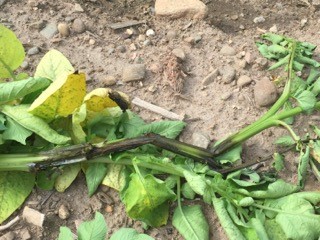Blackleg disease reported in some Michigan potato fields
Aerial and lower stem blackleg in potatoes are ever present, but some years worse than others.

Aerial blackleg can look like stem and petiole late blight and is being reported in some potato crops in the southern growing areas of Michigan. The bacterium tends to affect single stems and can be distinguished from late blight by the absence of a disease focus, so usually only a single stem on an isolated plant is obvious. The margin between the disintegrated and sound tissue is clear and nearly odorless. However, secondary rots, such as Clostridium spp. and Pseudomonas spp., invade the damaged and diseased tissue, causing the rot to progress quickly through the stem and possibly develop into a chalky-white, foul-smelling, slimy mass (Photo 1).
Blackleg and bacterial soft rot are potato diseases caused by different but closely related bacteria, Pectobacterium atroseptica (Pca) and P. carotovorum (Pcc), respectively – also formerly known as Erwinia spp. The bacteria are ubiquitous and can be found on the surfaces and in the lenticels of seed and daughter (progeny) potato tubers, on farm machinery, soil and storage area surfaces. Disease development in the field, in both soil and aerial environments, is enhanced by warm, moist conditions. The bacteria are spread in and on potato seed pieces from one area to another. However, the bacteria can also proliferate and be spread on potato stems from previous crops, soil on potato tubers, insects, mechanically by soil movement or human activity, and of course in water. These bacteria can decay stems, plant root systems and clog or destroy the vascular system and rot tubers in the field as well as in potato storages.
This disease is named after the black lesions that are produced on infected stems (Photos 1-2). Infected plant stems are inky black and can extend from the decaying seed piece up the entire length of the stem or appear only on upper parts of the stem. The stem vascular system, or pith, may be decayed and discolored (gray) above the severely decayed portion of the stem. In time, leaves turn yellow and leaflet margins tend to roll upwards. Leaflets, and later entire plants, wilt and eventually decline and die. Under wet conditions – precipitation and irrigation – the decay is characteristically wet and slimy and may spread quickly up the outside of the stem. This stem decay can also be seen after European corn borers exit the stems. The root systems may also be brown or black, decayed and non-functional.

Black lesions on infected potato stems caused from blackleg disease.
Blackleg control
Growers should only plant certified seed. Seed is only certified if it is within the incidence tolerance of tuber presence with soft-rot symptoms (0.05 percent), but the seed is unlikely to be completely free of Pca contamination. Pca does not survive well outside of the potato, therefore rotational programs of two or more years may help control this disease. Seed cutting can also spread inoculum, therefore sanitation and disinfesting potato cutting equipment and careful seed handling post-cutting reduces the risk of this disease. Prevention of seed piece decay with fungicidal seed treatments can indirectly prevent seed contamination, especially during the cutting operation. Seeds should be planted during conditions that favor fast emergence, and planting into cool and wet soils should be avoided.
Control of blackleg and bacterial soft rot of tubers (in store)
As Pcc is opportunistic, it is prudent to manage other diseases that can infect tubers such as late blight, early blight, Fusarium dry rot, Pythium leak and pink rot. Michigan State University Extension recommends the following cultural methods for limiting soft rot.
- Copper fungicides are partially effective and dry out existing lesions.
- Avoid over irrigation.
- Avoid excessive fertilization, which may impact plant and tuber maturity.
- Do not apply fungicides that enhance phyto-potential, i.e., strobilurins after early canopy senescence.
- Delay harvest until skin set is complete, usually up to 21 days after desiccation, and avoid wet conditions during harvest which also eliminates the soil from sticking to the skin.
- Suberize potatoes in storage to promote wound healing and reduce the infection sites for the pathogen (50 degrees Fahrenheit at 95 percent relative humidity) for 14 days.
- If potatoes are harvested wet, they must be ventilated until they are dry and before the suberization process is started (see above).
- Contaminated potato lots should be stored separately.
- Storages should be checked regularly for temperature increase and odors. If detected, hot-spot fans should be used to cool the pile (Techmark in Lansing, Michigan, supplies these).
- Minimizing potato bruising by harvesting during dry conditions.
- Avoid washing tubers into storage unless absolutely necessary.
- Avoid excessive heat or cold during harvest and transport.
- Applications of Storox at storage may be warranted.
Dr. Kirk’s work is funded in part by MSU’s AgBioResearch.



 Print
Print Email
Email




